
Super Mario World 2: Yoshi's Island is a 1995 platform game developed and published by Nintendo for the Super Nintendo Entertainment System (SNES). The player controls Yoshi, a friendly dinosaur, on a quest to reunite baby Mario with his brother Luigi, who has been kidnapped by Kamek. Yoshi runs and jumps to reach the end of the level while solving puzzles and collecting items with Mario's help.

F-Zero X is a futuristic racing video game for the Nintendo 64 console. Developed and published by Nintendo, it was released in Japan, North America, and Europe in 1998. In 2000, the Expansion Kit was released in Japan, including a track and vehicle editor. The original game was ported in 2004 to the iQue Player in China. It had Virtual Console re-releases on the Wii in 2007 and the Wii U around nine years later. On March 11, 2022, the game was re-released on Nintendo Switch Online + Expansion Pack, featuring online multiplayer.
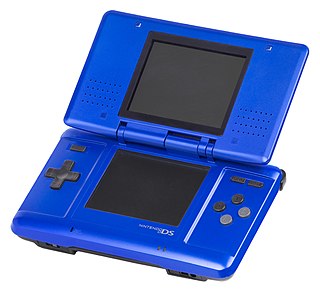
The Nintendo DS is a 32-bit foldable handheld game console produced by Nintendo, released globally across 2004 and 2005. The DS, an initialism for "Developers' System" or "Dual Screen", introduced distinctive new features to handheld games: two LCD screens working in tandem, a built-in microphone and support for wireless connectivity. Both screens are encompassed within a clamshell design similar to the Game Boy Advance SP. The Nintendo DS also features the ability for multiple DS consoles to directly interact with each other over Wi-Fi within a short range without the need to connect to an existing wireless network. Alternatively, they could interact online using the now-defunct Nintendo Wi-Fi Connection service. Its main competitor was Sony's PlayStation Portable during the seventh generation of video game consoles.

The Rumble Pak is a removable device from Nintendo that provides force feedback while playing video games. Games that support the Rumble Pak cause it to vibrate in select situations, such as when firing a weapon or receiving damage, to immerse the player in the game. Versions of the Rumble Pak are available for the Nintendo 64, the Nintendo DS, and the Nintendo DS Lite. A select few Game Boy Color and Game Boy Advance (GBA) games use a similar technology built into the game cartridge. Force feedback vibration has become a built-in standard feature in almost every home video game console controller since.
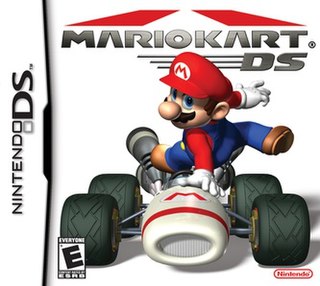
Mario Kart DS is a 2005 kart racing video game developed and published by Nintendo for the Nintendo DS handheld game console. It was released in November 2005 in North America, Europe, and Australia, and on December 8, 2005, in Japan. The game was re-released for the Wii U's Virtual Console in North America and PAL regions in April 2015 and in Japan in May 2016. The game is the fifth main entry in the Mario Kart series, and the first to be playable via the Nintendo Wi-Fi Connection online service. Like other games in the series, Mario Kart DS features characters from the Mario series and pits them against each other as they race in karts on tracks based on locations in the Mario series.

Nintendogs is a real-time pet simulation video game developed and published by Nintendo for the Nintendo DS handheld video game console. It was released in Japan, and was later released in: North America, Australia, New Zealand, Europe and other regions. It was originally released in three different versions: Dachshund & Friends, Lab & Friends and Chihuahua & Friends. It has been re-released twice, first as a bundled release with a special edition Nintendo DS with a new version called Nintendogs: Best Friends and later as Nintendogs: Dalmatian & Friends.
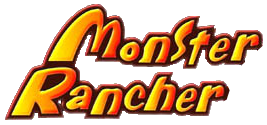
Monster Rancher, known in Japan as Monster Farm, is a Japanese media franchise and series of life simulation role-playing video games created by Tecmo. The series consists of fifteen games across numerous different video game platforms, and an anime adaptation that aired from 1999 to 2000.
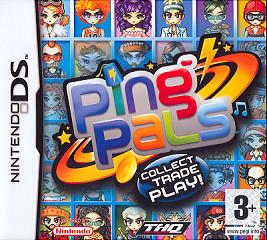
Ping Pals is a chat/accessory program developed by WayForward Technologies and published by THQ for the Nintendo DS. It was released on December 8, 2004 in North America & It was released in Europe in early 2005. The program allows the user to customise their "Ping Pal" avatar and game interface by selecting from over 1000 different items such as hairstyles, makeup, clothing, backdrops, music loops and sound effects.

Ogre Battle 64: Person of Lordly Caliber is a real-time tactical role-playing game developed by Quest Corporation and localized by Atlus USA for the Nintendo 64. Though conceptually similar to Ogre Battle: The March of the Black Queen, significant gameplay tweaks were implemented to change the game's overall flow. Ogre Battle 64 is the third game in the series, the first two being Ogre Battle: The March of the Black Queen, and Tactics Ogre. Gaidens have been released in Japan, on Game Boy Advance and Neo Geo Pocket Color. Unlike earlier Ogre Battle games, which feature Queen song titles, "Person of Lordly Caliber" is an original title. Ogre Battle 64 was released in PAL regions for the first time via the Wii Virtual Console in 2010.

Pokémon Ranger is an action role-playing video game developed by HAL Laboratory and Creatures Inc. and published by The Pokémon Company and Nintendo for the Nintendo DS video game console. The game was released on various dates, varying between continents. The game was released in Japan on March 23, 2006, in North America and Australia during 2006, and in Europe in April 2007. It was released on the European Wii U Virtual Console on February 25, 2016.
The Virtual Console is a defunct line of downloadable video games for Nintendo's Wii and Wii U home video game consoles and the Nintendo 3DS family of systems.

Yoshi's Island DS, known in Japan as Yoshi Island DS, is a 2006 platform game developed by Artoon and published by Nintendo for the Nintendo DS. It was released in North America and Australia in November 2006, in Europe in December 2006, and in Japan in March 2007. It is a sequel to the 1995 SNES game, Super Mario World 2: Yoshi's Island. Announced at Nintendo's E3 press conference in May 2006, the game was well received by critics, scoring an average of 81% on Metacritic's aggregate. The game was originally to be titled Yoshi's Island 2, though its name was changed one month before its North American release. In April and May 2015, the game was made available for the Wii U via the Virtual Console service, shortly after a Nintendo Direct presentation.

Star Fox Command is a shoot 'em up video game, the fifth game in the Star Fox series, published by Nintendo for the Nintendo DS in 2006. Star Fox Command was announced at the E3 2006 conference, under the name Star Fox DS. Command is the first Star Fox game for a handheld, and supports the Nintendo Wi-Fi Connection, making it the first online Star Fox game. The game was re-released for the Wii U Virtual Console service in 2015.
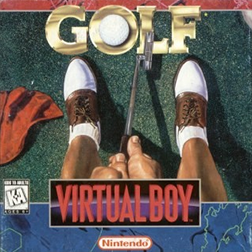
Golf is a video game that was released within months of the Virtual Boy console's launch. It was developed and published by T&E Soft in Japan and published by Nintendo in North America. Golf uses standard golf rules and is set in the fictional 18-hole Papillion Golf & Country Club. Hazards include water, sand traps, trees, and deep rough grass. It is displayed in the Virtual Boy's standard red and black color scheme with 3D effects by use of a 3D processor. It was met with critical praise for its controls and physics and mixed reviews for its graphics. Nintendo Power called it the third best Virtual Boy release of its year.
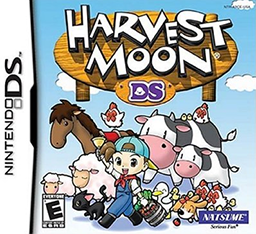
Harvest Moon DS, known in Japan as Bokujō Monogatari: Colobocle Station, is a farm simulation role-playing video game for the Nintendo DS, part of the Story of Seasons series. It was published and developed by Marvelous Interactive Inc., and released in Japan on March 17, 2005, and in North America on September 12, 2006. It is the first entry in the series without series creator Yasuhiro Wada heavily involved, though it borrows many assets from Harvest Moon: Friends of Mineral Town and Harvest Moon: A Wonderful Life, such as the graphical style from the former and setting of the latter.
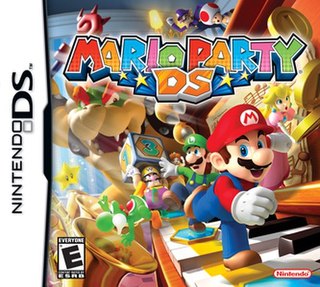
Mario Party DS is a 2007 party video game developed by Hudson Soft and published by Nintendo for the Nintendo DS. It is the second handheld game in the Mario Party series, as well as the last game in the series to be developed by Hudson Soft, as all subsequent titles have been developed by NDcube. The game was re-released on the Virtual Console for the Wii U in April 2016.

Build-A-Bear Workshop is a simulation video game for the Nintendo DS based on the retailer of the same name. It was developed by French company Neko Entertainment and published by The Game Factory for release on November 5, 2007. A follow-up, known as Build-A-Bear Workshop: A Friend Fur All Seasons, was released for the Wii in 2008. Two additional video games, Build-A-Bear Workshop: Welcome to Hugsville and Build-A-Bear Workshop: Friendship Valley, were released for the Nintendo DS and Wii, respectively, in 2010. Since The Game Factory went out of business before they were released, both games were published by Activision instead.

Baby Pals is a simulation-style video game for the Nintendo DS developed by American studio Brain Toys that released in North America and in the PAL region in late 2007 and early 2008. The objective of the game is to take care of a virtual baby through certain tasks as feeding, bathing, and teaching just like a real father or mother would do. Players can choose the gender of the baby.
There have been a variety of Sesame Street video games released for video game platforms. Most of the Sesame Street video games were published and developed by NewKidCo.
















